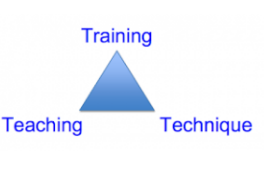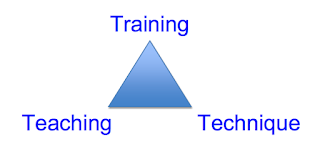
This post was written by John Carrier and originally posted on his Coaching Basketball Blog
I hope that you might be able to use these thoughts to put together a similar system to get the most out of your spring improvement season individual skill workouts.
The diagram below is one I use on a daily basis when structuring practice.
It’s a great way to ensure the activities you are doing in practice meet the current needs of your team.
I’m not sure where I got it from, but I am confident I stole it from somewhere. Apologies to the person who didn’t get credit.
The triangle is used in two ways. First, I use it to analyze WHY I am doing a various practice activity.
I try to be very systematic about planning practice and using the right tool to teach a given aspect of the game.
To me, ANY team activity outside of warm ups fall into one of three categories:
- Teaching
- When you are showing the players how to do something, you are in the teaching phase of practice.
- This is usually categorized by instruction, demonstration, and players doing the action at a speed of 75% or less.
- I know it’s time to move past the teaching stage when players can verbalize or explain the action you are teaching and can also show you how to do it correctly.

- Technique
- Technique accounts for most traditional “drills”. Anything where players are performing a given aspect of the game and really focusing on technique.
- This category is identified by it’s focus on performing a single action repeatedly between 75% and full speed. It’s also identified by it’s lack of game like environment and randomness.
- I know it’s time to move past technique when players can correctly perform the action in a drill setting, at game speed, over and over again (85%-100% correct).
- Training
- Training is any full (5 on 5) or small sided game in practice with rule modifications used to focus the game on the skill you are using. Also can be any small sided or full sided games in general that allows players to APPLY the skill in a realistic game setting.
- This is the type of activity to use when players can perform a skill in drills, but seem to “forget” or not be able to perform it in a live game.
- This is where you get the carry over from practice to games.
The key here is to look at everything you do in practice and understand why you are doing it. If your players can’t tell you how to do something, then you need to teach (or re-teach) it. If they can correctly explain the skill, and preform it at game speed in a drill, then they need to spend time in training activities. At the same time you can’t jump into training activities before players can perform the movement correctly. It’s a important balance to strike in your practices, and is important to understand where your players are in regards to the skills you are trying to teach them. As a rule of thumb if they don’t know – I teach. If they know, but can’t do it – we drill technique. If they can do it correctly in a drill but not a game – we train.
I will use defensive slides as an example. At the beginning of the year I spend 5-8 minutes TEACHING the footwork. I demonstrate it (or have a player demonstrate it), then have everyone do it in slow motion. We might break into partners and do it in slow motion until everyone has a feel for it. I’ll even ask a few players how to perform the movement to see if they at least KNOW what they should be doing. After that we go through some traditional drills – mass stance, 1 on 1 dummy cut offs, etc. Once we see players doing it technically correct, we move into training. In training we play variations of 1 on 1 and 2 on 2 that force them to defend the ball constantly. As they play, I watch their form. If they start to develop poor technique, we move back to technique. We alternate between technique and training as needed, with the occasional “reteach” thrown in when warranted.






